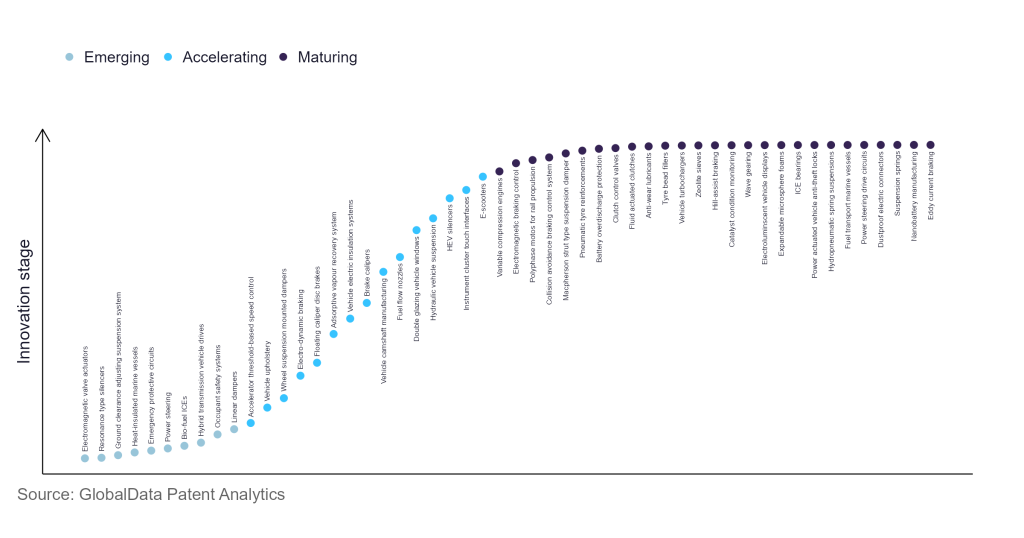The automotive industry continues to be a hotbed of innovation, with activity driven by enhanced engine efficiency and the regulations to reduce emissions, and growing importance of technologies such as artificial intelligence and Internet of Things. In the last three years alone, there have been over 1.2 million patents filed and granted in the automotive industry, according to GlobalData’s report on Innovation in Automotive: Vehicle turbocharger vanes. Buy the report here.
However, not all innovations are equal and nor do they follow a constant upward trend. Instead, their evolution takes the form of an S-shaped curve that reflects their typical lifecycle from early emergence to accelerating adoption, before finally stabilising and reaching maturity.
Identifying where a particular innovation is on this journey, especially those that are in the emerging and accelerating stages, is essential for understanding their current level of adoption and the likely future trajectory and impact they will have.
290+ innovations will shape the automotive industry
According to GlobalData’s Technology Foresights, which plots the S-curve for the automotive industry using innovation intensity models built on over 619,000 patents, there are 290+ innovation areas that will shape the future of the industry.
Within the emerging innovation stage, resilient spoke wheels, auto-transmission lubrication circuits, and ignition switching engines are disruptive technologies that are in the early stages of application and should be tracked closely. Engine purge actuators, electro-dynamic braking, and adsorptive vapour recovery system estimation are some of the accelerating innovation areas, where adoption has been steadily increasing. Among maturing innovation areas are collision avoidance braking control system and direct injection type engines, which are now well established in the industry.
Innovation S-curve for the automotive industry

Vehicle turbocharger vanes is a key innovation area in automotive
A variable geometry turbocharger (VGT) uses vanes to regulate the amount of air entering the turbine. These vanes are connected to an actuator that either opens or closes them. Closed vanes will deliver less amount of air but with more pressure to the turbine wheel, which decreases the turbo lag at low speeds as the exhaust gasses are pressurised. Open vanes deliver a larger amount of air to the turbine wheel, rolling the turbine faster and creating more boost or compression.
GlobalData’s analysis also uncovers the companies at the forefront of each innovation area and assesses the potential reach and impact of their patenting activity across different applications and geographies. According to GlobalData, there are 20+ companies, spanning technology vendors, established automotive companies, and up-and-coming start-ups engaged in the development and application of vehicle turbocharger vanes.
Key players in vehicle turbocharger vanes - a disruptive innovation in the automotive industry
‘Application diversity’ measures the number of different applications identified for each relevant patent and broadly splits companies into either ‘niche’ or ‘diversified’ innovators.
‘Geographic reach’ refers to the number of different countries each relevant patent is registered in and reflects the breadth of geographic application intended, ranging from ‘global’ to ‘local’.
Patent volumes related to vehicle turbocharger vanes
| Company | Total patents (2021 - 2023) | Premium intelligence on the world's largest companies |
| BorgWarner | 166 | Unlock Company Profile |
| Garrett Motion | 109 | Unlock Company Profile |
| Honeywell International | 108 | Unlock Company Profile |
| IHI | 95 | Unlock Company Profile |
| Mitsubishi Heavy Industries | 93 | Unlock Company Profile |
| Bosch Mahle Turbo Systems | 91 | Unlock Company Profile |
| Toyota Motor | 69 | Unlock Company Profile |
| IHI Charging System International | 60 | Unlock Company Profile |
| General Electric | 48 | Unlock Company Profile |
| Continental | 47 | Unlock Company Profile |
| Porsche Automobil Holding | 34 | Unlock Company Profile |
| FountainVest Partners | 34 | Unlock Company Profile |
| Siemens | 15 | Unlock Company Profile |
| Safran | 15 | Unlock Company Profile |
| Rolls-Royce Holdings | 12 | Unlock Company Profile |
| Williamsmpanies | 10 | Unlock Company Profile |
| Ford Motor | 10 | Unlock Company Profile |
| AB Volvo | 9 | Unlock Company Profile |
| ABB | 9 | Unlock Company Profile |
| Komatsu | 8 | Unlock Company Profile |
| Aisin | 8 | Unlock Company Profile |
| Hyundai Motor Group | 7 | Unlock Company Profile |
| Cummins | 7 | Unlock Company Profile |
| Nippon Steel Nisshin | 6 | Unlock Company Profile |
| General Motors | 5 | Unlock Company Profile |
Source: GlobalData Patent Analytics
BorgWarner is a key player in the vehicle turbocharger vanes innovation area. BorgWarner vehicle turbocharger vanes feature a robust electric actuator that controls the pressure upstream of the turbine and precisely adjusts the guide vanes for nearly instant acceleration and optimum power output. The company’s patented vehicle turbocharger vanes regulate the VTG turbine output and improve thermodynamics and engine response at very low rpm by changing the inflow angle and speed at the turbine wheel inlet. The turbocharger vanes enable excellent response and smooth power delivery while enhancing fuel efficiency and reducing emissions for a wide range of vehicle segments. Honeywell International, Mitsubishi Heavy Industries, Garrett Motion, and Bosch Mahle Turbo Systems are some of the other key players.
To further understand the key themes and technologies disrupting the automotive industry, access GlobalData’s latest thematic research report on Automotive.
Data Insights
From

The gold standard of business intelligence.
Blending expert knowledge with cutting-edge technology, GlobalData’s unrivalled proprietary data will enable you to decode what’s happening in your market. You can make better informed decisions and gain a future-proof advantage over your competitors.







